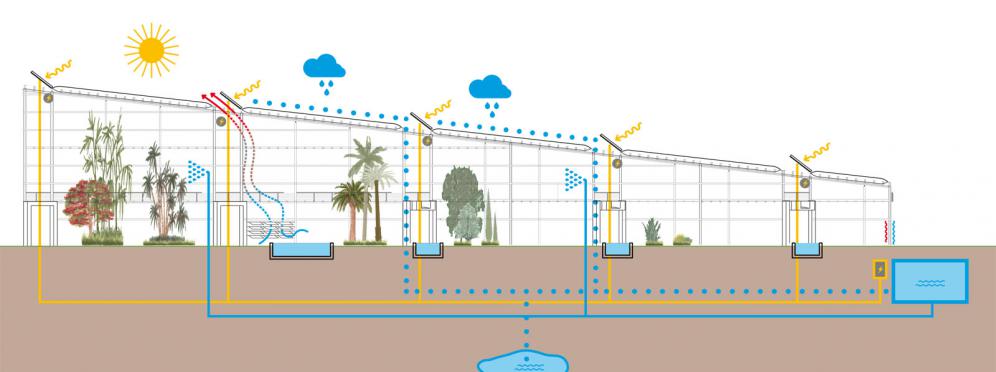Solar active building
The building has been designed to reduce environmental impact to a minimum.

The building has been designed to reduce environmental impact to a minimum – a 100 m long, 18 m high showcase in which the shape, layout of the spaces and installations have been optimised to exploit to the full the natural energy available free from the sun.
The building plays an active role in transforming both the inside and outside environment, thanks to design and technological features which reduce environmental impact.
Natural precipitation feeds a 450 m3 collecting pool. The same body of water which marks the entrance to the Biodiversity Garden also ensures constant mixing and oxygenation of the water reservoir. From a depth of 284 m, an artesian well takes up water at a constant 24°C, allowing tropical aquatic plants to live all year round. It also integrates the water reservoir in periods of drought.
Electricity produced by photovoltaic panels powers the pumps regulating the water cycle and contributes to operation of the entire greenhouse system. The opaque internal and external surfaces are covered with a photocatalytic compound which exploits ultraviolet rays to produce a chemical reaction. This considerably reduces atmospheric pollution - estimates speak of 150 m3/m2 cleaned of pollutants each day.
A new technique for growing shrubs has been used on the non-transparent roofs of the structures. Transforming these areas into places where plants can grow has positive effects on the environment, from reducing the building’s energy consumption to producing oxygen and reducing carbon dioxide and particulate.
The greenhouse effect is exploited to save energy and at the same time keep the environment within the temperature and humidity parameters specific to each climate zone. The heat produced by the sun’s rays remains imprisoned in the greenhouses. In winter, the masonry parts accumulate the heat and release it during the night. During the summer, the heat is mitigated by opening the glass walls and roofs of the greenhouses. And the signal to open and close the windows comes from the plants themselves as they react to the environmental conditions by releasing carbon dioxide and oxygen in different degrees as the humidity and temperature vary. A computerised system relates the data provided by the plants to the optimum parameters for life in each of the climate zones.
The greenhouse roofs are made from cushions of Ethylene Tetrafluoroethylene (ETFE), a corrosion resistant plastic, lighter than glass and more transparent to the UV rays vital for the plants. The roofs are shaped to accumulate the sun’s heat, creating a buffer of air which reduces dispersion by radiation during the night.
To obtain the visual effect of a 100 m long perfectly flat piece of glass, a new system has been devised to fix the panes, free from external profiles or through elements, but able to support wind loads of more than 400 kg/m2.






